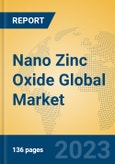Market Size and Growth Forecast
The global Nano Zinc Oxide market was valued at USD 0.9-1.8 billion in 2024, with an estimated CAGR of 6.0%-8.0% from 2025 to 2030, driven by demand in cosmetics and electronics.Regional Analysis
- North America is projected to grow at a CAGR of 5.5%-7.5%, with the U.S. leading due to its electronics and cosmetics sectors, focusing on high-purity nano zinc oxide.
- Europe is expected to achieve a CAGR of 5.3%-7.3%, with Germany driving demand through its emphasis on sustainable textile applications.
- Asia Pacific is anticipated to record the highest growth at 6.5%-8.5%, led by China and South Korea, where electronics and cosmetics industries fuel demand, with trends toward advanced coatings.
- Rest of the World, particularly Brazil, is expected to grow at 5.0%-7.0%, with trends toward masterbatch and plastics applications.
Application Analysis
- Rubber and latex applications are estimated to grow at a CAGR of 5.8%-7.8%, driven by tire manufacturing, with trends toward high-performance additives.
- Adhesives are projected to grow at 5.5%-7.5%, valued for bonding strength, with innovations in eco-friendly formulations.
- Plastics and masterbatch applications are expected to grow at 6.0%-8.0%, used for UV resistance, with advancements in nanotechnology.
- Textiles are projected to grow at 5.3%-7.3%, critical for antibacterial coatings, with trends toward sustainable fabrics.
- Cosmetics applications are expected to grow at 6.5%-8.5%, driven by sunscreen demand, with trends toward PFAS-free formulations.
- Other applications, including electronics, are projected to grow at 5.0%-7.0%, with trends toward transparent conductive films.
Key Market Players
Pan-Continental Chemical, headquartered in Taoyuan, Taiwan, produces nano zinc oxide for cosmetics, known for its high-purity solutions.Zhiyi Group, based in Shanghai, China, offers nano zinc oxide for textiles, emphasizing antimicrobial properties.
EverZinc, headquartered in Loncin, Belgium, provides nano zinc oxide for electronics, focusing on advanced nanotechnology.
Hakusui, based in Osaka, Japan, produces nano zinc oxide for rubber, known for its precision manufacturing.
TAEKYUNG SBC, headquartered in Seoul, South Korea, offers nano zinc oxide for cosmetics, emphasizing UV protection.
Shaanxi Sino Academy Nano Materials, based in Xi’an, China, provides nano zinc oxide for plastics, focusing on scalable production.
Luoyang Blue Sky Chemical Technology, headquartered in Luoyang, China, produces nano zinc oxide for adhesives, known for its innovative formulations.
Yuguang Gold & Lead, based in Jiyuan, China, offers nano zinc oxide for masterbatch, emphasizing high-purity products.
Shandong Xingya New Material, headquartered in Weifang, China, provides nano zinc oxide for rubber, known for its large-scale capacity.
Jiyuan Lutai Nanomaterials, based in Jiyuan, China, produces nano zinc oxide for electronics, focusing on nanotechnology expertise.
Porter’s Five Forces Analysis
- The threat of new entrants is moderate; high R&D costs and regulatory barriers limit entry, but nanotechnology advancements attract innovators.
- The threat of substitutes is high; alternative nanomaterials like titanium dioxide compete, challenging nano zinc oxide’s market share.
- Buyer power is moderate; electronics and cosmetics firms negotiate pricing, but specialized properties limit leverage.
- Supplier power is low; zinc raw materials are widely available, reducing supplier influence.
- Competitive rivalry is high; players differentiate through nanoparticle size control and eco-friendly innovations.
Market Opportunities and Challenges
Opportunities
- Growing cosmetics and electronics industries drive demand for nano zinc oxide.
- Advancements in nanotechnology enhance market potential in healthcare and textiles.
- Emerging markets in Asia Pacific offer growth due to industrial and consumer demand.
Challenges
- Regulatory concerns over nanomaterial safety increase compliance costs.
- High R&D costs for advanced nano zinc oxide limit adoption.
- Competition from alternative nanomaterials poses market share risks.
Growth Trend Analysis
The Nano Zinc Oxide market is growing rapidly, driven by cosmetics and electronics demands. Yuguang Gold & Lead currently has a nano zinc oxide capacity of 10,000 tons, focusing on masterbatch applications. Shandong Xingya New Material maintains a capacity of 38,000 tons, emphasizing rubber applications. Jiyuan Lutai Nanomaterials holds a capacity of 10,000 tons, targeting electronics. On October 15, 2024, Chongqing Dongqun completed its first-phase 10,000-ton nano zinc oxide project, with a second-phase 20,000-ton project under construction, signaling significant capacity expansion in China. These developments align with a projected CAGR of 6.0%-8.0% through 2030, reflecting the industry’s focus on nanotechnology and sustainability.This product will be delivered within 1-3 business days.
Table of Contents
Companies Mentioned
- Pan-Continental Chemical
- Zhiyi Group
- EverZinc
- Hakusui
- TAEKYUNG SBC
- Shaanxi Sino Academy Nano Materials Co. Ltd.
- Luoyang Blue Sky Chemical Technology Co. Ltd
- Yuguang Gold & Lead
- Shandong Xingya New Material
- Jiyuan Lutai Nanomaterials








